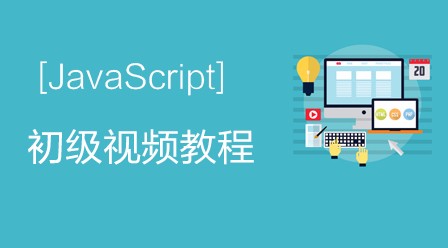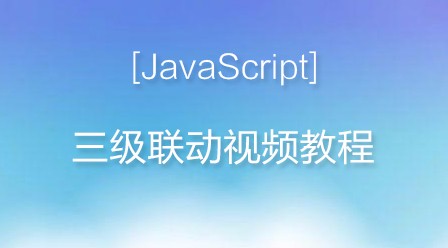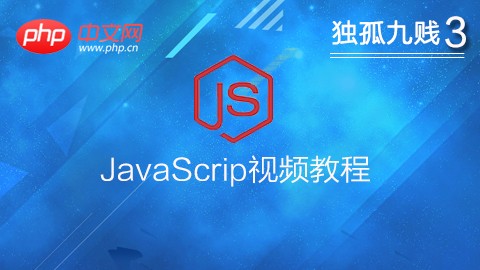最近好多伙伴说,我用vue做的项目本地是可以的,但部署到服务器遇到好多问题:资源找不到,直接访问index.html页面空白,刷新当前路由404。。。用react做的项目也同样遇到类似问题。现在我们一起讨论下单页面如何部署到服务器?
由于前端路由缘故,单页面应用应该放到nginx或者apache、tomcat等web代理服务器中,千万不要直接访问index.html,同时要根据自己服务器的项目路径更改react或vue的路由地址。
如果说项目是直接跟在域名后面的,比如:http://www.sosout.com ,根路由就是 '/'。
如果说项目是直接跟在域名后面的一个子目录中的,比如: http://www.sosout.com/children ,根路由就是 '/children ',不能直接访问index.html。
以配置Nginx为例,配置过程大致如下:(假设:
1、项目文件目录: /mnt/html/spa(spa目录下的文件就是执行了npm run dist 后生成的dist目录下的文件)
2、访问域名:spa.sosout.com)
进入nginx.conf新增如下配置:
server { listen 80; server_name spa.sosout.com; root /mnt/html/spa; index index.html; location ~ ^/favicon/.ico$ { root /mnt/html/spa; } location / { try_files $uri $uri/ /index.html; proxy_set_header Host $host; proxy_set_header X-Real-IP $remote_addr; proxy_set_header X-Forwarded-For $proxy_add_x_forwarded_for; proxy_set_header X-Forwarded-Proto $scheme; } access_log /mnt/logs/nginx/access.log main;}注意事项:
1、配置域名的话,需要80端口,成功后,只要访问域名即可访问的项目
2、如果你使用了react-router的 browserHistory 模式或 vue-router的 history 模式,在nginx配置还需要重写路由:
server { listen 80; server_name spa.sosout.com; root /mnt/html/spa; index index.html; location ~ ^/favicon/.ico$ { root /mnt/html/spa; } location / { try_files $uri $uri/ @fallback; index index.html; proxy_set_header Host $host; proxy_set_header X-Real-IP $remote_addr; proxy_set_header X-Forwarded-For $proxy_add_x_forwarded_for; proxy_set_header X-Forwarded-Proto $scheme; } location @fallback { rewrite ^.*$ /index.html break; } access_log /mnt/logs/nginx/access.log main;}为什么要重写路由?因为我们的项目只有一个根入口,当输入类似/home的url时,如果找不到对应的页面,nginx会尝试加载index.html,这是通过react-router或vue-router就能正确的匹配我们输入的/home路由,从而显示正确的home页面,如果browserHistory模式或history模式的项目没有配置上述内容,会出现404的情况。
简单举两个例子,一个vue项目一个react项目:
vue项目:
域名:http://tb.sosout.com
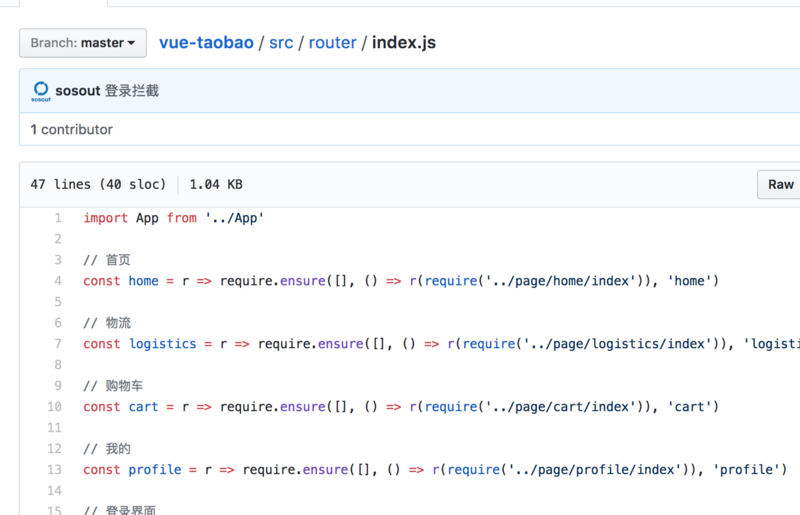
############# 其他配置############http { ############ # 其他配置 ############ server { listen 80; server_name tb.sosout.com; root /mnt/html/tb; index index.html; location ~ ^/favicon/.ico$ { root /mnt/html/tb; } location / { try_files $uri $uri/ @fallback; index index.html; proxy_set_header Host $host; proxy_set_header X-Real-IP $remote_addr; proxy_set_header X-Forwarded-For $proxy_add_x_forwarded_for; proxy_set_header X-Forwarded-Proto $scheme; } location @fallback { rewrite ^.*$ /index.html break; } access_log /mnt/logs/nginx/access.log main; } ############ # 其他配置 ############ }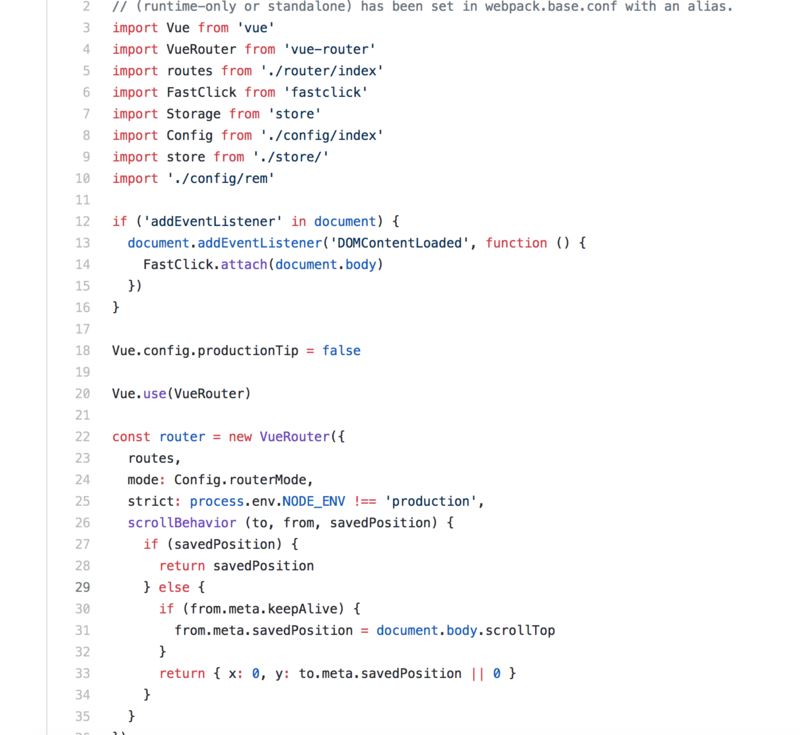
import App from '../App'// 首页const home = r => require.ensure([], () => r(require('../page/home/index')), 'home')// 物流const logistics = r => require.ensure([], () => r(require('../page/logistics/index')), 'logistics')// 购物车const cart = r => require.ensure([], () => r(require('../page/cart/index')), 'cart')// 我的const profile = r => require.ensure([], () => r(require('../page/profile/index')), 'profile')// 登录界面const login = r => require.ensure([], () => r(require('../page/user/login')), 'login')export default [{ path: '/', component: App, // 顶层路由,对应index.html children: [{ path: '/home', // 首页 component: home }, { path: '/logistics', // 物流 component: logistics, meta: { login: true } }, { path: '/cart', // 购物车 component: cart, meta: { login: true } }, { path: '/profile', // 我的 component: profile }, { path: '/login', // 登录界面 component: login }, { path: '*', redirect: '/home' }]}]react项目:
域名:http://antd.sosout.com
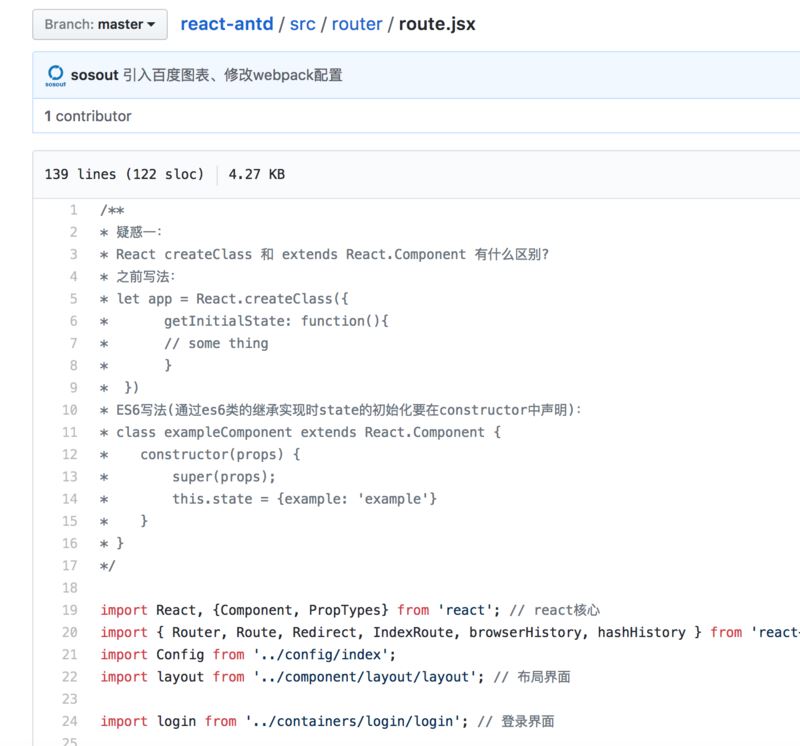
/*** 疑惑一:* React createClass 和 extends React.Component 有什么区别?* 之前写法:* let app = React.createClass({* getInitialState: function(){* // some thing* }* })* ES6写法(通过es6类的继承实现时state的初始化要在constructor中声明):* class exampleComponent extends React.Component {* constructor(props) {* super(props);* this.state = {example: 'example'}* }* }*/import React, {Component, PropTypes} from 'react'; // react核心import { Router, Route, Redirect, IndexRoute, browserHistory, hashHistory } from 'react-router'; // 创建route所需import Config from '../config/index';import layout from '../component/layout/layout'; // 布局界面import login from '../containers/login/login'; // 登录界面/** * (路由根目录组件,显示当前符合条件的组件) * * @class Roots * @extends {Component} */class Roots extends Component { render() { // 这个组件是一个包裹组件,所有的路由跳转的页面都会以this.props.children的形式加载到本组件下 return ( <div>{this.props.children}</div> ); }}// const history = process.env.NODE_ENV !== 'production' ? browserHistory : hashHistory;// 快速入门const home = (location, cb) => { require.ensure([], require => { cb(null, require('../containers/home/homeIndex').default) }, 'home');}// 百度图表-折线图const chartLine = (location, cb) => { require.ensure([], require => { cb(null, require('../containers/charts/lines').default) }, 'chartLine');}// 基础组件-按钮const button = (location, cb) => { require.ensure([], require => { cb(null, require('../containers/general/buttonIndex').default) }, 'button');}// 基础组件-图标const icon = (location, cb) => { require.ensure([], require => { cb(null, require('../containers/general/iconIndex').default) }, 'icon');}// 用户管理const user = (location, cb) => { require.ensure([], require => { cb(null, require('../containers/user/userIndex').default) }, 'user');}// 系统设置const setting = (location, cb) => { require.ensure([], require => { cb(null, require('../containers/setting/settingIndex').default) }, 'setting');}// 广告管理const adver = (location, cb) => { require.ensure([], require => { cb(null, require('../containers/adver/adverIndex').default) }, 'adver');}// 组件一const oneui = (location, cb) => { require.ensure([], require => { cb(null, require('../containers/ui/oneIndex').default) }, 'oneui');}// 组件二const twoui = (location, cb) => { require.ensure([], require => { cb(null, require('../containers/ui/twoIndex').default) }, 'twoui');}// 登录验证const requireAuth = (nextState, replace) => { let token = (new Date()).getTime() - Config.localItem('USER_AUTHORIZATION'); if(token > 7200000) { // 模拟Token保存2个小时 replace({ pathname: '/login', state: { nextPathname: nextState.location.pathname } }); }}const RouteConfig = ( <Router history={browserHistory}> <Route path="/home" component={layout} onEnter={requireAuth}> <IndexRoute getComponent={home} onEnter={requireAuth} /> // 默认加载的组件,比如访问www.test.com,会自动跳转到www.test.com/home <Route path="/home" getComponent={home} onEnter={requireAuth} /> <Route path="/chart/line" getComponent={chartLine} onEnter={requireAuth} /> <Route path="/general/button" getComponent={button} onEnter={requireAuth} /> <Route path="/general/icon" getComponent={icon} onEnter={requireAuth} /> <Route path="/user" getComponent={user} onEnter={requireAuth} /> <Route path="/setting" getComponent={setting} onEnter={requireAuth} /> <Route path="/adver" getComponent={adver} onEnter={requireAuth} /> <Route path="/ui/oneui" getComponent={oneui} onEnter={requireAuth} /> <Route path="/ui/twoui" getComponent={twoui} onEnter={requireAuth} /> </Route> <Route path="/login" component={Roots}> // 所有的访问,都跳转到Roots <IndexRoute component={login} /> // 默认加载的组件,比如访问www.test.com,会自动跳转到www.test.com/home </Route> <Redirect from="*" to="/home" /> </Router>);export default RouteConfig;
############# 其他配置############http { ############ # 其他配置 ############ server { listen 80; server_name antd.sosout.com; root /mnt/html/reactAntd; index index.html; location ~ ^/favicon/.ico$ { root /mnt/html/reactAntd; } location / { try_files $uri $uri/ @router; index index.html; proxy_set_header Host $host; proxy_set_header X-Real-IP $remote_addr; proxy_set_header X-Forwarded-For $proxy_add_x_forwarded_for; proxy_set_header X-Forwarded-Proto $scheme; } location @router { rewrite ^.*$ /index.html break; } access_log /mnt/logs/nginx/access.log main; } ############ # 其他配置 ############ }下面看下vue和react区别
前端都知道3个主流框架,vue,react,anjular,当然目前最火的还是vue和react,那么vue 和react 的区别?
相同点:
1.都支持服务器端渲染
2.都有Virtual DOM,组件化开发,通过props参数进行父子组件数据的传递,都实现webComponent规范
3.数据驱动视图
4.都有支持native的方案,React的React native,Vue的weex
5.都有管理状态,React有redux,Vue有自己的Vuex(自适应vue,量身定做)
不同点:
1.React严格上只针对MVC的view层,Vue则是MVVM模式
2.virtual DOM不一样,vue会跟踪每一个组件的依赖关系,不需要重新渲染整个组件树.
而对于React而言,每当应用的状态被改变时,全部组件都会重新渲染,所以react中会需要shouldComponentUpdate这个生命周期函数方法来进行控制
3.组件写法不一样, React推荐的做法是 JSX + inline style, 也就是把HTML和CSS全都写进JavaScript了,即'all in js';
Vue推荐的做法是webpack+vue-loader的单文件组件格式,即html,css,jd写在同一个文件;
4.数据绑定: vue实现了数据的双向绑定,react数据流动是单向的
5.state对象在react应用中不可变的,需要使用setState方法更新状态;
在vue中,state对象不是必须的,数据由data属性在vue对象中管理;
就对我而言吧,vue适合开发移动端项目,react适合开发pc端项目(个人观点),
当然我还是喜欢 React,毕竟后台大,哈哈,虽然现在升级到16版本了(不喜勿喷)
总结
以上所述是小编给大家介绍的vue、react等单页面项目应用部署到服务器的方法,希望对大家有所帮助,如果大家有任何疑问请给我留言,小编会及时回复大家的。在此也非常感谢大家对脚本之家网站的支持!
您可能感兴趣的文章:
- vue、react等单页面项目应该这样子部署到服务器
- 客户端(vue框架)与服务器(koa框架)通信及服务器跨域配置详解
- vue 打包后的文件部署到express服务器上的方法
- Vue项目webpack打包部署到服务器的实例详解
- Vue.js项目部署到服务器的详细步骤
